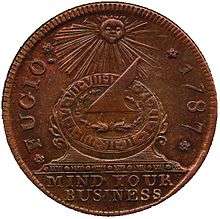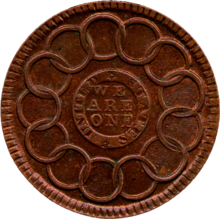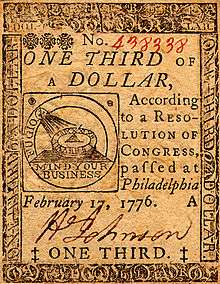Fugio cent
The Fugio cent, also known as the Franklin cent,[1][2] is the first official circulation coin of United States. Consisting of 0.36 oz of copper, it was designed by Benjamin Franklin and minted only in 1787. Its design is very similar to a 1776 Continental Currency dollar coin that was produced in pattern pieces as potential Continental currency but was never circulated.
United States | |
| Value | 0.01 U.S. dollar |
|---|---|
| Mass | 10.2 g |
| Composition | Cu |
| Obverse | |
 | |
| "New Haven Restrike", probably produced at the Scovill Mint in Waterbury, Connecticut | |
| Design | "Mind Your Business", Sun, and sundial |
| Designer | Benjamin Franklin |
| Design date | 1787 |
| Reverse | |
 | |
| Design | "We Are One", 13 state chain links |
| Designer | Benjamin Franklin |
| Design date | 1787 |
History

On April 21, 1787, the Congress of the Confederation of the United States authorized a design for an official copper penny,[3] later referred to as the Fugio cent because of its image of the Sun and its light shining down on a sundial with the caption, "Fugio" (Latin: I flee/fly, referring to time flying by). This coin was designed by Benjamin Franklin; as a reminder to its holders, he put at its bottom the message, "Mind your business". This design was based on the 1776 "Continental dollar" coin, which was produced in pattern pieces but was never circulated.[4]
Some historians believe that the word "business" was intended literally here, as Franklin was an influential and successful businessman. It does not mean "mind your own business" as that phrase is used today, but rather, "pay attention to your affairs".[1]
The reverse side of both the 1776 Continental dollar coins and paper notes, and the 1787 coins, bore the third motto "We Are One" (in English) surrounded by thirteen chain links, representing the original thirteen colonial states. Following the reform of the central government with the 1788 ratification of the 1787 Constitution, gold and silver coins transitioned to the motto "E pluribus unum" from the Great Seal of the United States.
The Bank of New York Hoard
In 1788, the Bank of New York stored several thousand Fugio cents in a keg in its basement. In 1856, the coins were put into cotton bags and stored away again. The trove was rediscovered in 1926.[2] The coins were then given out as souvenirs and keepsakes to clients until 1948 when the American Numismatic Society examined the remaining 1,641 coins. The cache became known as the Bank of New York Hoard. Several of the coins were donated to the society while others were sold to collectors.[2][5] All of the coins found were in mint state condition, most with brown toning and some with water damage.[5][6] The bank retained 819 of the coins.[5][7]
See also
- Nova Constellatio (1783 pattern pieces)
- Large cent (United States coin) (1793–1857)
- History of the United States dollar
- United States dollar
References
- Taylor, Sol. "300th Birthday Retrospective: The Coinage of Ben Franklin". The Signal. SCVTV. Retrieved March 21, 2019.
- "The Fugio Cent of 1787: Introduction". Coin and Currency Collections. University of Notre Dame. Retrieved November 18, 2016.
- Norton, Frank Henry; et al. (1875). "Notes and Queries". American Journal of Numismatics. 10 (1): 21. Retrieved April 25, 2016.
- "The Story of Money: 11 – Coin Design Inspired Fugio Cent". Federal Reserve Bank of Atlanta. Retrieved August 28, 2016.
- Yeoman, R. S.; Bressett, Kenneth (2017). A Guide Book of United States Coins. Whitman Publishing. p. 31.
- Green, Paul M. (July 24, 2012). "More Than Morgans in Coin Hoards". www.numismaster.com. Retrieved November 19, 2016.
- Wnuck, Dave (September 13, 2013). "Collecting the Coins of Famous Hoards" (PDF). www.hlrc.com. Retrieved November 19, 2016.
External links
- U.S. Mint: Circulating Coins FAQ at the Wayback Machine (archived March 19, 2008)
- U.S. Mint: 1776 Continental "Dollar"
| Preceded by None |
United States one-cent coin (1787) |
Succeeded by Chain cent |